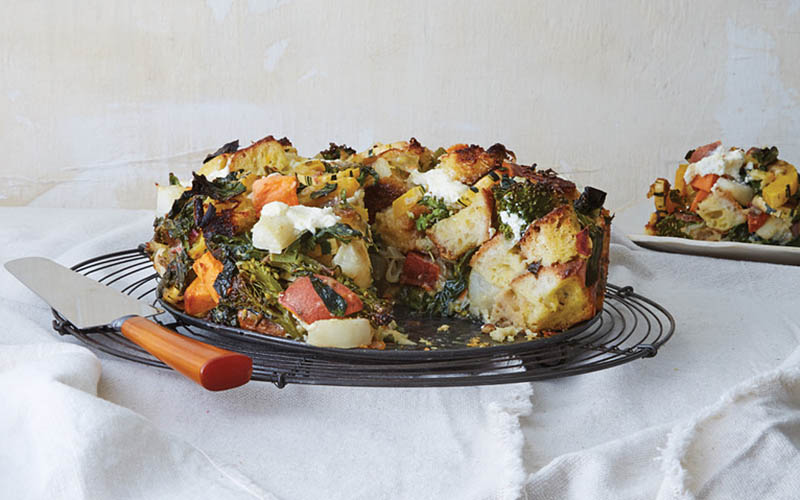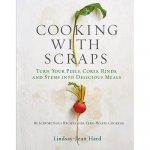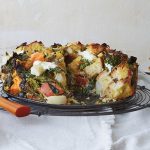
A strata is a versatile dish for clearing out odds and ends in the fridge, and it’s make-ahead friendly. In the interest of full disclosure: I could easily pass on stuffing, bread pudding, French toast—you get the idea. So why on earth would I tell you to make a strata? Well, for starters, I’ve met very few people who share my indifference to mildly mushy bread-focused dishes, so the odds are good that you enjoy them, too. But secondly, a strata is one of the best ways to put stale bread to good use. So even though they aren’t my favorite, they still make a regular appearance at my house, because I love bread, and I don’t always finish it before it gets stale. I normally use a 3-quart casserole dish for a strata, which makes enough for 4 to 6 servings, and plan to use 6 to 8 cups of cubed (to 1 inch) stale bread. You can use any size dish you choose though; toss in the bread cubes as you cut them until it’s mostly—but not all the way—full, then measure how much you have and adjust the egg-and-milk ratio accordingly.
— Lindsay-Jean Hard
 Excerpted from Cooking with Scraps by Lindsay-Jean Hard. Published by Workman Publishing. © 2018 Lindsay-Jean Hard. Photo by Penny De Los Santos.
Excerpted from Cooking with Scraps by Lindsay-Jean Hard. Published by Workman Publishing. © 2018 Lindsay-Jean Hard. Photo by Penny De Los Santos.

| Servings |
| 4 -6 servings |
|
|

|
If your bread for this strata isn’t stale to start with, you have a couple of options for getting it there. If you’re not in a rush, place thick slices of bread on a baking sheet or for even better air circulation, a cooling rack, and leave the slices to dry out for a day. The faster option involves your oven. I pop cubes of bread on a baking sheet in a 200°F oven and leave them in there while I prep other ingredients—they will dry out in about 40 minutes or so. If you want them to dry even faster, crank it up to 350°F, but pay closer attention—your bread cubes will be toasted in 15 to 20 minutes.
|
- Butter for greasing the baking dish, plus more (optional) for sautéing the filling
- 6 large eggs
- 1-1/4 cups milk (for an eggier strata, up the amount of eggs; for a mushier strata, add more milk)
- Fine-grain sea salt and pepper, to taste
- Up to 6 cups uncooked or 3 cups cooked vegetables and meat for the filling (see step 3)
- olive oil for sautéing the filling (unless using butter)
- 6 to 8 cups cubed (3/4 to 1 inch) stale bread (see note above)
- 3/4 to 1-1/2 cups grated or crumbled cheese, depending on how many cheese nubs you’re trying to clear out (and how cheesy you want it to be)
- Grease a 3-quart baking dish with butter.
- Whisk the eggs and milk together along with a healthy pinch of salt and a few grinds of pepper, and set aside.
- Vegetables and meat need to be cooked before baking, so chop any uncooked items and sauté them with a little butter or olive oil. The amounts you choose can vary widely, and remember that most will shrink after cooking, so it’s hard to overdo it. A small or medium onion and a garlic clove or two are always a good start, and then think about what you have left in your fridge that might work well together. A half pound of sausage and a bunch of spinach (cook the sausage first, and then add the greens to wilt them), or a package of mushrooms with bacon and Swiss cheese, or leftover squash with a small bunch of Swiss chard, or cherry tomatoes with corn cut off of a couple of cobs and blobs of ricotta. (Note that leftover cooked meats and vegetables don’t need to be cooked again.)
- Spread about half the bread cubes in the bottom of the buttered dish, then layer on half of the cheese and half of the vegetables and meat. Then repeat: Layer on the rest of the bread and remaining ingredients.
- Pour the egg and milk mixture over everything. Cover and refrigerate for at least 30 minutes or up to 1 day.
- Preheat the oven to 350°F. Remove the dish from the refrigerator and bake, covered with aluminum foil, for 30 to 40 minutes. Uncover at the end for some browning action if desired.

